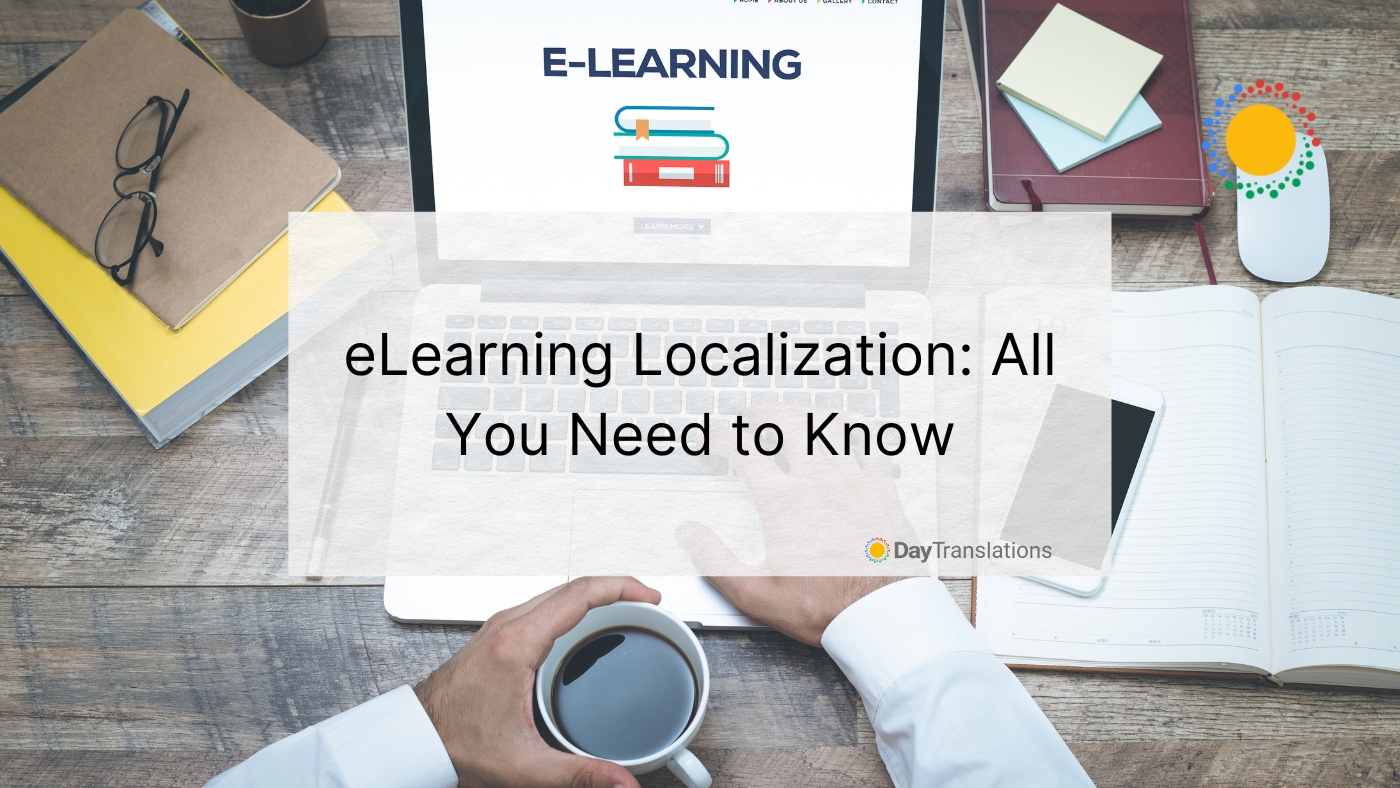Before diving into this article, if you truly want an answer to What is Localization, check out this link to read our full guide on L10N.
___________________________________________________
More and more people around the world are eager to learn or pursue continuing education. eLearning is one of the easiest solutions to gain more knowledge. Busy people can now continue learning in their own time and their own pace.
What is eLearning?
Simply put, eLearning is learning using electronic means to access an educational degree, program or course without going to a conventional classroom.
So many terms describe eLearning, including online learning, distance education, Internet education and computerized electronic learning. Technically, you can define eLearning as interactive classes delivered through the Internet. The classes are either prerecorded or delivered live. Learners’ progress is monitored, with a teacher or a professor communicating, interacting and grading the students’ participation. Just like a typical classroom study, the teacher also gives tests and assignments. For many people, eLearning is one of the most viable way to have an education.
eLearning’s Profitability
Since the mainstream application of eLearning in the early part of the new millennium, eLearning’s usage has been on the rise. Statistics prove that it is a valuable learning tool that has benefitted many companies, creating a new sector in the learning industry. Just look at some of these amazing statistics.
· It’s projected that by 2025 the market for eLearning will be about $325 billion.
· As of 2017, around 77% of the corporations in the United States used eLearning.
· In the same year, eLearning through smartphones were offered by 67% of the companies in the U.S.
· The retention rate for people who used eLearning methods is around 25% to 60%.
The growth potential of eLearning is huge. Companies that have used eLearning between 2001 and 2017 grew by 900%. About 43% of the organizations in the U.S. that used eLearning grew their income by around 24%.
The increase in usage and profitability of eLearning and the fact that it is online means that people in different parts of the world can access eLearning programs. This means that to achieve a higher audience reach, it has to be available in different languages. Given that many people want to increase their knowledge it is vital that eLearning courses should be localized.
eLearning Applications
eLearning is very effective for training, remotely or on site. It can help your workforce develop additional skills or update the skills they already have. eLearning can be used for the following types of training:
1. Employee training
One of the most common types of eLearning is employee training. It makes training new hires faster and easier, allowing them to gain knowledge about the company and learn about the job that will be assigned to them. The delivery of the employee training is uniform and consistent, making the process more efficient. With exams, reports and feedback, it is easier to assess the employees’ performance.
2. Compliance training
Many organizations have to comply with regulations, laws and guidelines. Using eLearning, employees are informed about the regulations and the impact they have on their jobs and the company. It’s mandatory to provide compliance training, which can be about dignity in the workplace, safety and health. Compliance training could focus on diversity, human resources laws and anti-harassment.
3. Customer training
You might think it odd to be training customers. But in reality, this is very valuable. It is a popular program for providers of software products, machinery, medical devices and other products where customers have to fully understand how to use a product. It provides the customers with enhanced user experience through simulations, which increases user engagement and retention of customers.
4. Reseller or partner training
This type of training provides your business partners with the right tools to become better members of your business network. You can create eLearning materials to guide them in their marketing efforts, product support training, sales training and product information training. Your partners will be able to retain more knowledge through eLearning. They can view the program as many times as they want, which is better than you hosting a seminar, where participants are likely to forget most of the information that were disseminated.
Localizing eLearning
If your eLearning program is designed to be used by learners from different countries, it is essential not only to translate your lessons but to localize them.
Localization is part of the translation process wherein the content is adapted to a specific region. The adaptation of the content means translating it into the target language. However, the process does not stop at translation of the written text. It also adapts the other elements, such as the font, the colors, the images and signs to local culture. These elements should be replaced with things that are more acceptable to the intended users, such as the things that they are used to seeing and using.
In eLearning localization, even if the lessons are culture-neutral, it’s still important to consider particular examples, because it is vital to avoid offending learners.
eLearning localization makes the lessons more engaging because they will fit the culture of the intended users. It makes the course appropriate to a specific culture, making the lessons more effective.
Elements and Features That Are Commonly Localized
Whether your eLearning material is a simple video, a PowerPoint presentation or a robust, full-scale course delivered through a learning management system (LMS), its elements and features will need translation and localization if you’re targeting a multilingual market.
The most common eLearning features that should be localized are the following:
· The written content
· Graphics and images
· Elements for user experience such as the navigation buttons
· Video elements
· Audio elements
· Formats such as dates, time, addresses, units of measure, currency
Steps for Localizing eLearning
Localizing eLearning is a complex process that should be done by experts in the field. The project scope varies depending on the type of eLearning modules the eLearning program contains.
Here are the steps necessary to make the localization of eLearning material a success.
1. Evaluation
Analysis of the entire material is vital. You should assess the cultural and technical viewpoints to ascertain the objectives, content that are culture-specific and the target users.
The evaluation of the eLearning program comprises the assessment of the source content, its layout including the type and number of graphic elements used. It also includes determining the file format, the register and the frequency of the appearance of common terms.
Part of the evaluation process is the selection of the software and tools to be used in the localization as well as choosing the members of the localization team, which may also include professional voice talents for the audio component of the eLearning program, graphic artists or designers. The casting of the voice talents is included in the evaluation process, upon the approval of the client.
2. Preparation
In the preparation phase, the team extracts the text from the files in their original formats. The charts, graphs and graphics should also be prepared. Preparation includes transcribing the audio script. The time stamps should be included to guide the voice talents during recording.
3. Translation, editing and proofreading of text files
In this step, the texts that were extracted from the source files are translated. Native-speaking translators as well as proofreaders and editors should do editing and proofreading of the translated texts.
4. Client review – first round
Once the written elements of the eLearning program are translated and localized, edited and proofread, the proofs are delivered to the client for their internal review.
5. Revisions
This step is optional. Revisions will depend on whether client finds things that should be changed or replaced. Otherwise, the team proceeds to the next phase of the localization process.
6. Recording of voice overs
The voice overs are recorded by the approved voice talents. It is vital that the studio director be a native speaker to ensure the accuracy of the recording. It’s important to do this step in a professional recording studio to ensure that professional recording system and other equipment are used to ensure the clarity and quality of the recording.
7. Client review – second round
The audio files are submitted for client review. The client could request edits which can be due to errors in the script. The client may request for faster or slower speed or they have a preference regarding the style of pronunciation.
8. Re-recording of voice overs based on the changes
Again this is an optional step if client requests for some changes.
9. Desktop publishing/localization engineering
Once all the requested changes were implemented, the translation and the voice over recording are finalized. The desktop publisher will see to it that all the visual elements, especially the graphics are formatted into the requested language. The graphic artists or designers should have localized the visual elements according to the preferences of the target culture at this stage.
The localization engineers will later sync the recorded audio files to the animations in the learning modules. They will ensure that every element runs properly.
10. Final QA
The final quality assessment will be done by a language tester. The person will see to it that the audio files are clear and seamlessly match the modules’ animations.
11. Delivery
The localization team delivers the final file in the format requested.
These are the most important things you should know about eLearning localization. It is better to prepare your eLearning material for localization by planning for multilingual content from the beginning. This ensures that the transition would be better. This will guide the eLearning creator to consider the structure of the text and how the language is used, such as avoiding idiomatic expressions, slang and humor that might be difficult to translate into other languages. Other things to consider are contraction and expansion of text when translated into other languages and the use of colors, graphics and images.
Choose the Right Partner for eLearning Localization
ELearning localization is a daunting task that should be done only by professionals. And you can find experienced localization professionals at Day Translations, Inc. We understand the complexity and technicalities involved in localization work. So, when you’re looking for high-quality and accurate eLearning localization services, give us a call at 1-800-969-6853 or send us an email at Contact us. We’re available 24/7, every day of the year.












Sorry, the comment form is closed at this time.